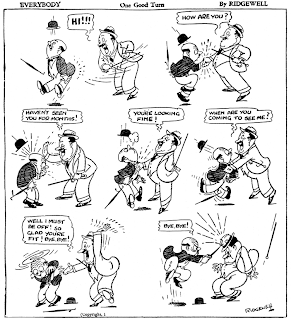Wednesday, April 04, 2012
Obscurity of the Day: Everybody
Everybody was distributed by Bell Syndicate probably starting in 1924 (Cole Johnson says he has seen examples as early as March of that year), and the latest were seen by Dave Strickler in the San Francisco Daily Herald, where the series ends on May 29. So there's a whopping three months of production that we know of. Did it run longer? Well, that seems like a chance, because Bell Syndicate either sold the series to a reprint syndicate or was selling it in reprints itself much later. The only place I've laid my own peepers on the strip is in the Philadelphia Sunday Dispatch, where it ran in 1929. It seems doubtful that you would bother to resurrect and reprint a series that only ran three months. But maybe the cachet of the creator(s) made it worthwhile.
The strip was credited to William Ridgewell, who was a British cartoonist of some note. The British sensibility is quite evident in the strip, and my guess is that Everybody was either composed of cartoons already printed in Punch, Tit-Bits and the like, or were rejects from the British magazines.
Now here's the oddball thing. Although the strip was credited to Ridgewell, in my Dispatch samples I have a few strips drawn and signed by another noted British cartoonist, H.M. Bateman. Neither Johnson or Strickler noted this in their perusals of the series, so maybe the Bateman cartoons were added to the reprint run to bulk it up some -- I dunno. But somehow, Everybody became a team effort among those two leading lights of British magazine cartooning.
Labels: Obscurities
Comments:
The other oddball thing is note that the copyright is listed as "(Copyright" here; in other installments I've found online, it's that or "(Copyright, 1" and the like. At Newspapers.com, I found the full copyright in the 1920s, such as "(Copyright, 1984, by The Bell Syndicate, Inc.)". It seems like it's in the 1930s and onwards the copyright notice is trimmed. Based on my © understanding, printing those strips in that fashion likely left them bereft of protection? They should have been printed with Copyright (or Copyright ©) plus the year plus the owner during most of the period in which notice was required.
In the reprint runs the year would be routed out because it would date the material. Imagine a reader seeing a copyright of 1924 on material he's reading in a 1932 newspaper. It just doesn't look so good. The syndicate selling this old material would take those copyrights off because they weren't concerned about copyrights, they were interested in the coupla bucks they could wring out of this old material. They left the word "Copyright" figuring that it gave the material some slight bit of panache -- worthy of being protected! -- Allan
Post a Comment




